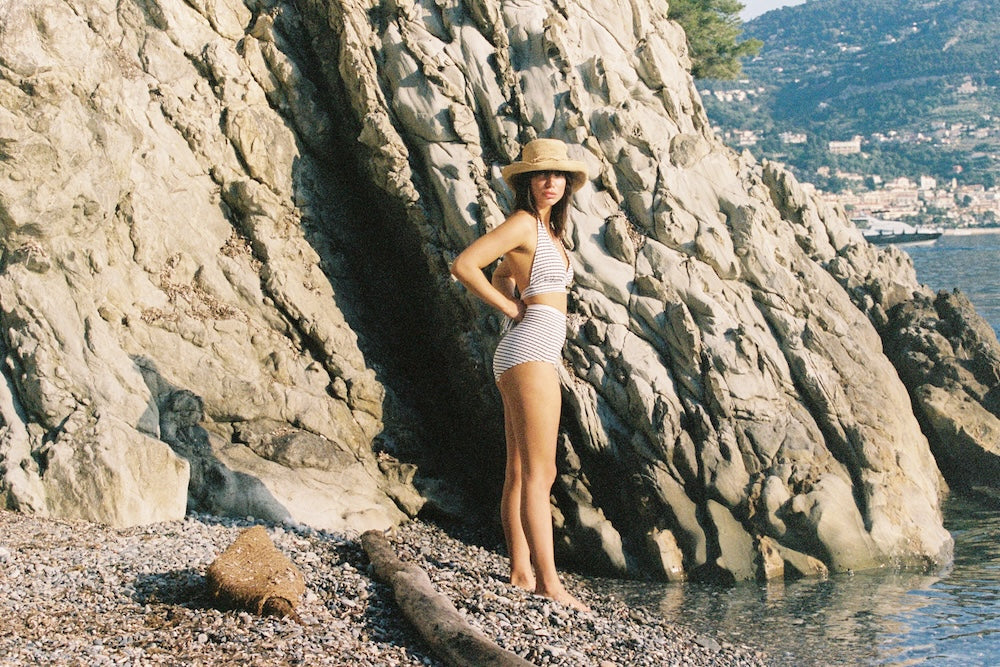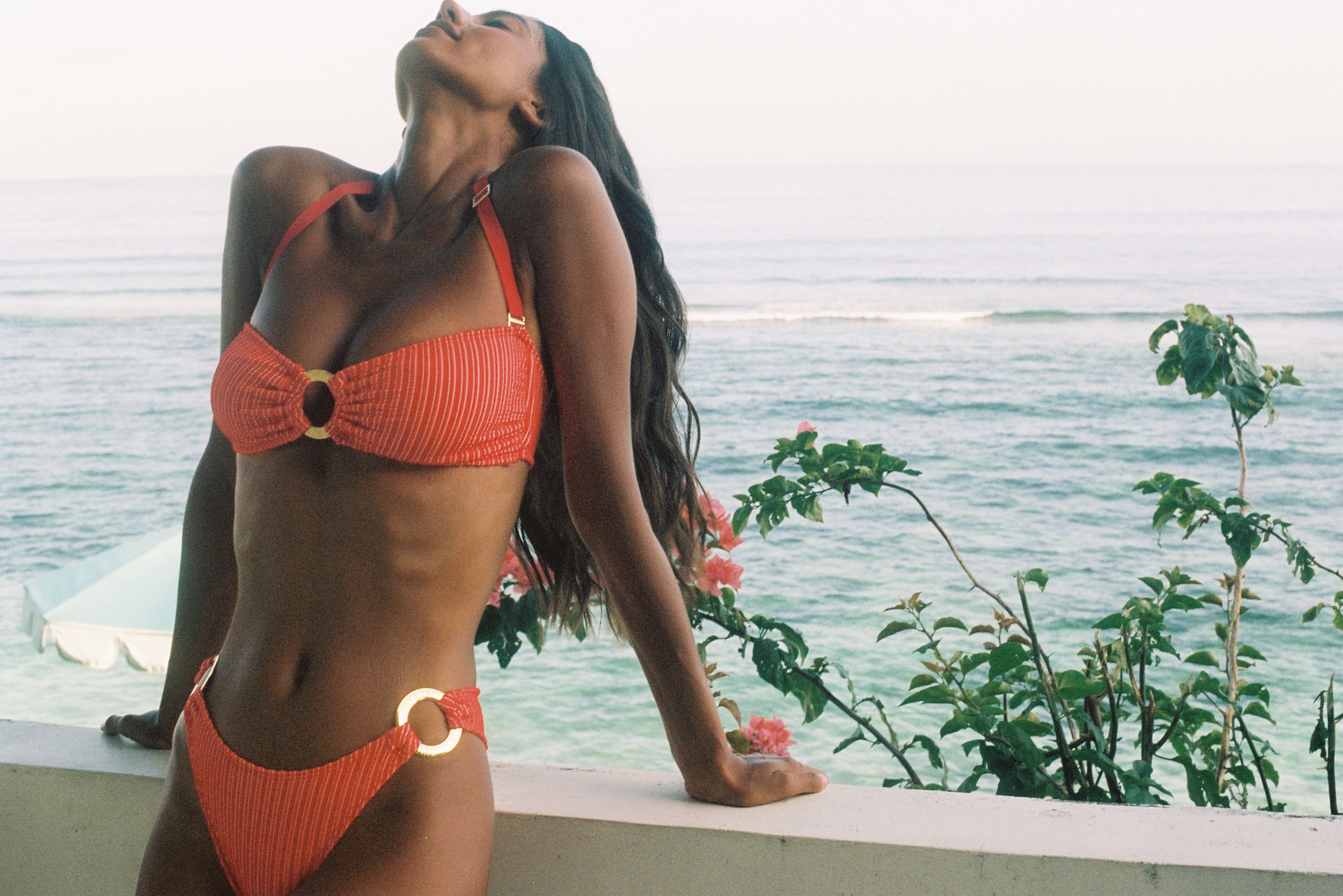The concept of slow fashion isn't new; in fact, it goes way back to the pre-industrial revolution days.
In the past, people would buy clothing and textiles with durability in mind. This would serve them for a long period of time and could be reused and repaired. It was also much more common to knit, weave, and sew clothing from available resources. These garments would reflect the place and culture of those wearing them.
Today, big retailers and fast fashion rule the clothing and swimwear marketplace. While this swimwear may be trendy and affordable, it's also wasteful, low quality, and often harmful to people and the environment. There are plenty of modern brands that still follow the slow fashion model and focus on making high quality swim products that are timeless, fashionable, and durable.
WHAT IS SLOW FASHION SWIMWEAR?
Slow fashion is a movement that seeks to reduce waste, improve quality, and promote sustainability. This includes making sure consumers buy high-end products that will last longer, while still being mindful of how those clothes are produced. Slow fashion is about slowing down our consumerism, and giving ourselves more time to think about what we wear. The slow fashion movement rejects the idea that we must buy something new every season. Instead, it promotes buying less frequently, choosing well-made items that will last longer, and supporting local businesses.
Fast fashion companies like H&M and Zara have become household names over the past few decades. They sell cheap clothing at high volume, relying heavily on cheap labor, poor environmental practices, and short product lifespans. And because of their affordability, consumers often buy from these brands without much thought about where it comes from or how it affects people and the environment.
However, there has been an increased backlash against fast fashion, and a growing interest in slow fashion. Sustainable bikini brands such as Patagonia, Uniqlo, and Koraru are taking steps towards creating products that are better for both consumers and the planet. Slow fashion shopping focuses on buying items that are well-made, sustainable, ethical, and affordable. A lot of people are now interested in buying clothes that don't fall apart quickly, but rather can be worn over and over again. They want to feel good about what they wear, and know that they're buying from local businesses and communities that they want to support.
HOW DOES SLOW FASHION SWIMWEAR DIFFER FROM REGULAR SWIMWEAR?
Fast fashion is a phrase thrown around quite often. Brands like Zara, H&M, Forever 21, and many others are known for producing clothing items that are meant to be disposable and trendy. While there are some benefits to buying fast fashion, such as price and convenience, there are drawbacks too.
For example, fast fashion tends to prioritize profit over longevity. This means that the clothes you buy today might not even make it a few wears without ripping, tearing, stretching, or showing other signs of wear. Most fast fashion retailers sell their clothes at prices that are much lower than those of traditional luxury labels, and they are able to do this by using cheap, low quality fabric.
On the other hand, slow fashion is about making sure that the clothes you purchase actually last longer. These types of companies tend to produce clothing that is made from high-quality materials and designed to last. Because it takes more time and resources to produce, slow fashion is also more expensive than fast fashion. However, the extra cost is worth it because the luxury swimsuits you wear will likely last for several seasons.
Slow fashion is becoming increasingly popular among shoppers looking for something different. There are plenty of options when shopping for slow fashion swimsuits, including slow fashion brands like Bali, LuluLemon, and Koraru. Each brand offers unique styles and designs that fit every woman's body type.
SWIMWEAR FABRICS
A lot goes into making responsible beachwear. From manufacturing processes to cut and fit to sizing, there are many factors to consider. But the creation of swimwear always starts from the sourcing material: fabric. And there are many different types of fabric out there.
- NATURAL MATERIALS
A century ago, the go-to fabrics for swimwear were natural fabrics like wool and cotton and were knitted. Although these fabrics were "natural" and somewhat better for the environment than the synthetics we use now, they weren't always the best materials.
Cotton grows very quickly, requires lots of energy to produce even when organically grown, and produces a large amount of waste during the growing process. And even though organic cotton farming uses up to 90% less water than conventional methods, requires little or no pesticides and fertilizers, and produces fewer greenhouse gases, it still requires a lot of energy. However, cotton and wool absorb water, and lose their shape after taking on water - not ideal for swimming. Hemp is another popular and natural material choice for eco friendly swimwear, but it doesn't hold up well against chlorine.
- SYNTHETIC MATERIALS
Most modern swimwear has been crafted from high-stretch synthetic materials such as nylon, polyester, or elastane. These fabric types are relatively durable, dry quickly, can be made to be chlorine and UV-resistant, cheap, stretchy, and comfortable. Synthetic fabrics have a lot going for them (even more than we can cover in this post)! Rayon is another popular choice for swimwear, especially for women's bikinis. However, rayon is often manufactured using toxic chemicals. Women's swimsuits made of nylon or virgin plastic have similar issues, as these plastics aren't biodegradable. Because they don't break down naturally over time, they end up polluting our oceans and harming marine life. Fortunately, there are several innovative eco-friendly swim fabrics out there.
- RECYCLED MATERIALS
Recycling is good for the environment because it reduces landfill, saves energy, and saves resources. In fact, the majority of sustainable swimwear manufacturers now source their fabric from recycled sources and regenerated fabrics. This includes ECONYL® regenerated yarn, polyester, cotton, Lycra, and even bamboo. One of these materials, ECONYL®, is regenerated nylon made from pre- and post-consumer products. To make ECONYL® regenerated yarn, waste like fishing nets, textile scrapes, and carpet flooring are collected and recycled. Then, the nylon is purified and transformed into new swimwear products.
WHAT TO LOOK FOR WHEN SHOPPING FOR SLOW FASHION SWIMWEAR
Slow fashion swimwear is more than just durability and recycled fabrics - it's about making smarter choices when shopping. Shoppers should also look for plastic-free packaging, minimalism, timeless designs, high quality fabrics, and other sustainability initiatives when shopping for slow fashion swimwear.
PACKAGING.
Many brands spend a lot of money on their branding and packaging. While marketing and branding is an important part of any successful business, truly sustainable brands will try to reduce their packaging wherever possible and invest in plastic-free alternatives to minimize waste. If the swimsuit is made overseas, this is going to have an even bigger environmental impact due to the transportation and packaging involved. Paying attention to this carbon footprint is important to overall consideration of a brand, but is an aspect that is often overlooked.
There are companies like Ecomoda that help consumers find the best way to buy clothing online while reducing their carbon footprint. They do this by helping customers choose the best option based on their location, size, and preferences. This company helps shoppers reduce their carbon footprint by providing information on the carbon emissions associated with each product purchased.
MINIMALISM.
Most consumers have bought that fancy unique article of clothing, only to realize it's uncomfortable, matches very few other pieces, and will sit in the back of your closet forever. Whether it's a sparkly shirt for a New Year's party that ends up being scratchy and itchy, or a super cute one piece swimwear cut-out monokini that gives you weird tan lines and so you can only wear it a few times on the right occasions out of the sun, we are almost all guilty of this fashion faux pas. Think about your go-to pieces. More often than not, it's the minimalism of them that makes you keep reaching for them, time and time again. Make your next bikini purchase a piece of minimalist swimwear, and soon it will be the go-to bikini.

TIMELESS DESIGNS.
Timeless designs are staples of a stylish and timeless wardrobe and don't cater to everchanging trends. They are also comfortable and wearable: buy sustainable beachwear that is made to be lived in and swam in so you can wear it for years to come. With luxury beachwear, you can always add your own touches by styling it. The zig-zag strap on our Zabel one piece suit can be moved around and styled in different ways. The double strap on the Kumanomi top is designed to flatter the upper body area. And our coral-inspired prints are designed beautifully and simply to go with a variety of body types and always flatter.
HIGH QUALITY FABRICS.
We all have dealt with swimsuits that sag after one week of wearing it in the pool. High quality fabrics have durable features such as ultrachlorine resistance, not stretching over time, and have gone through fabric quality control. Sustainable swimwear made of this fabric will actually hold up in the pool, ocean, or lake. Look for fabrics such as ECONYL (mentioned above), or you can use a tool such as the Higgs Index or look for the Oeko Tex Standard 100 certification. This certification is recognized globally as the standard for textile products sold in Europe. Products that carry the label meet strict requirements regarding animal welfare, environmental protection, and human health.
SUSTAINABILITY INITIATIVES.
Does the brand itself talk about their company sustainability initiatives? Just as we as consumers need to focus on the sustainability of our purchases, truly eco-friendly brands will be focused on their own sustainability initiatives, and will hopefully be eager to share these initiatives on their website. Initiatives beyond fabric and design, such as being transparent about their supply chain, using renewable energy, purchasing carbon offsets, or donating a portion of proceeds to local nonprofits are all great signs a company actually cares about making a difference in the world.

WHY BUY SLOW FASHION?
The best slow fashion brands always go a step beyond what is required. In Koraru's case - "it's about giving back to the natural world where we draw our inspiration from and where we spend our time wearing our swimsuits, because being grateful for the beauty that surrounds us is part of the slow fashion and mindful consumption movement." - Oana Romaneiro, founder
The fashion industry is one of the most polluting industries in the world. In 2017 alone, it generated over 2 billion tons of carbon dioxide emissions - equivalent to the amount of CO2 emitted by all the cars on the road worldwide. And while there are many ways to reduce our impact on the environment, one way is to buy products that are produced sustainably. Brands like Koraru make sure that the people producing their clothing are treated fairly and paid well. They also ensure that the factories where their garments are manufactured are clean and safe places to work.
Overall, when thinking about slow fashion, buy less but better. Whenever you shop, you are showing support for that retailer and brand. Before making any purchase, ask yourself: do you support the brand, and are you buying for the right reasons? Opting for timeless eco friendly bikinis from luxury swim brands has a ripple effect across the entire swimwear supply chain. This mindful consumption will help make our planet a better place, one purchase at a time.
Written by Neesha Basnyat - Sustainability Writer for Koraru
Neesha Basnyat is a an experienced sustainability writer and researcher specialising in biology, sustainability, CSR, and ESG analysis and reporting. With an educational background in Biology and Environmental Science and over 6 years of experience in the sustainability field, Neesha loves everything green, from shoveling compost to calculating emissions or researching the best new standards in the sustainability space.




